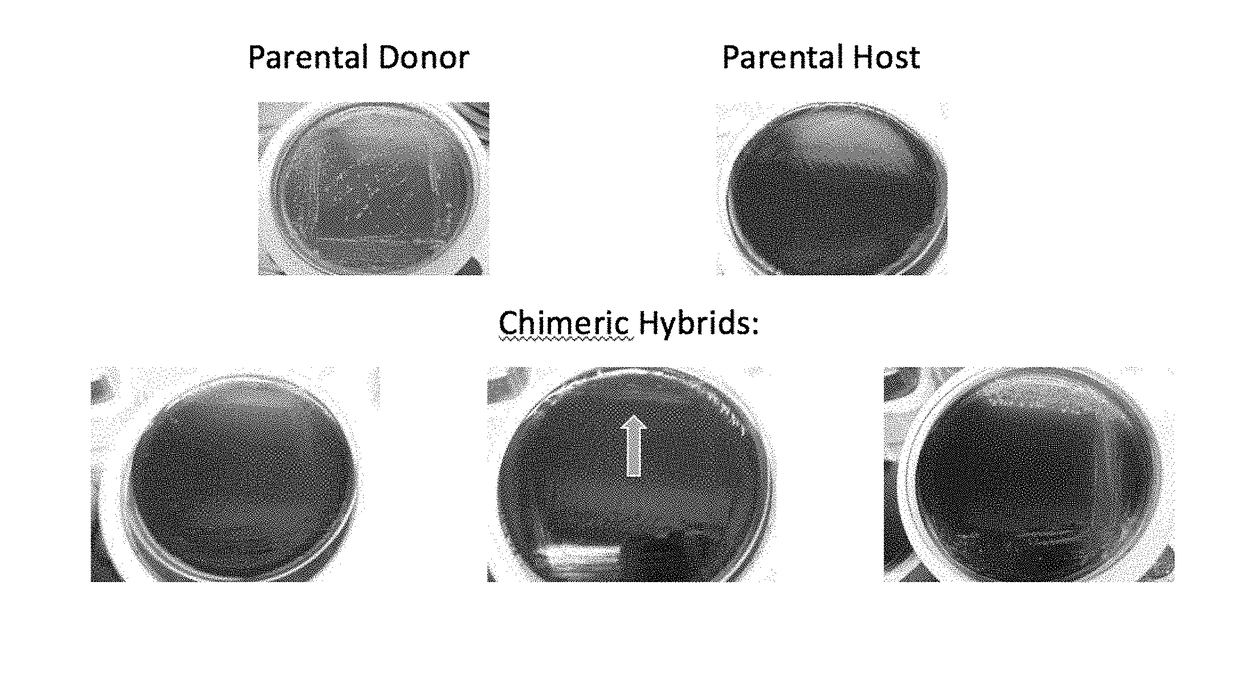Method for Producing Chimeric Microbial Hybrids
a technology of chimeric microbial hybrids and chimeric bacteria, which is applied in the field of transferring chromosomal dna, can solve the problems of not using a pre, and achieve the effect of reducing, reducing, or eliminating
- Summary
- Abstract
- Description
- Claims
- Application Information
AI Technical Summary
Benefits of technology
Problems solved by technology
Method used
Image
Examples
example 1
Lactobacillus plantarum Amino Acid Auxotrophy Removal with Ethanol Pre-Stressor
[0178]The desired parental host in this experiment was Lactobacillus plantarum. The phenotype to be acquired was provided by the parental donor, Clostridium beijerinckii. The desired trait for genetic transfer was amino acid prototrophy, or survival on a minimal medium containing no proteins or amino acids; the clostridial parent can grow on minimal medium at 35-37° C. anaerobically. The Lactobacillus parent cannot grow on a medium without proteins or added amino acids.
[0179]MICs for stressors were determined. C. beijerinckil's optimal temperature for growth is 32° C. with an MIC of 39° C. L. plantarum has an optimal temperature for growth at 37° C. with an MIC of 44° C. Selected gene transfer medium was a minimal medium that did not contain amino acids or proteins. The Clostridium parent is an obligate anaerobe whereas the Lactobacillus parent is a facultative anaerobe. The chosen atmospheric conditions ...
example 2
L. plantarum Amino Acid Auxotrophy Removal with UV Pre-Stressor
[0187]The desired parental host was Lactobacillus plantarum. The desired phenotype to be transferred was provided by the parental donor, Clostridium beijerinckii. The desired trait for genetic transfer was amino acid prototrophy, or survival on a minimal medium plate containing no proteins or amino acids.
[0188]C. beijerinckii can grow on minimal medium at 35° C. anaerobically. L. plantarum cannot grow on a medium without proteins or added amino acids. C. beijerinckii's optimal temperature for growth is 32° C. with an MIC of 39° C. The Lactobacillus parent strain has an optimal temperature for growth at 37° C. with an MIC of 44° C. Selected gene transfer medium was a minimal medium that contained no proteins or amino acids.
[0189]Pre-stressors included two different conditions with short bursts of ultraviolet (UV) light. One condition applied UV light inside in an aerobic biosafety cabinet in open petri dishes, for 3×2 sec...
example 3
Saccharomyces cerevisiae Var. Boulardii Sorbitol Metabolism Addition
[0203]The desired parental host in this experiment was Saccharomyces cerevisiae var. boulardii. The phenotype to be acquired was provided by the parental donor, Metschnikowia reukaffi, a wild nectar yeast. The desired trait for genetic transfer was sorbitol metabolism, or survival on a protein rich medium with sorbitol as the only carbohydrate source. The nectar yeast donor can grow on this same protein rich medium containing sorbitol at 23-34° C. aerobically. The Saccharomyces parent cannot grow on a minimal medium with sorbitol as the sole carbon source; however, it can grow on minimal medium with starch or glucose as the carbon source.
[0204]MICs for stressors were determined. M. reukaffi's optimal temperature for growth is 29° C. with an MIC of 35-36° C. S. cerevisiae var. boulardii has an optimal temperature for growth at 34° C. with an MIC of 44° C. The selected gene transfer medium contained yeast extract alon...
PUM
 Login to View More
Login to View More Abstract
Description
Claims
Application Information
 Login to View More
Login to View More - R&D
- Intellectual Property
- Life Sciences
- Materials
- Tech Scout
- Unparalleled Data Quality
- Higher Quality Content
- 60% Fewer Hallucinations
Browse by: Latest US Patents, China's latest patents, Technical Efficacy Thesaurus, Application Domain, Technology Topic, Popular Technical Reports.
© 2025 PatSnap. All rights reserved.Legal|Privacy policy|Modern Slavery Act Transparency Statement|Sitemap|About US| Contact US: help@patsnap.com



